
views
Creating a Space to Dry Your Clothes
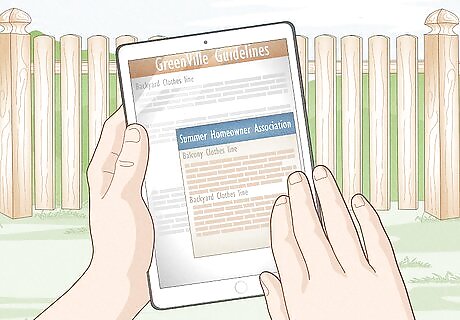
Check your local regulations. In some places, clotheslines are forbidden on balconies and in backyards because the sight of clothes hanging out to dry is considered "unsightly" and liable to bring down property prices. So, you'll need to know the local rules first, including that of the local homeowner's association. If you live in an area where this is an issue, you might like to join those advocating for relaxation of such rules so that you can save money and energy too.
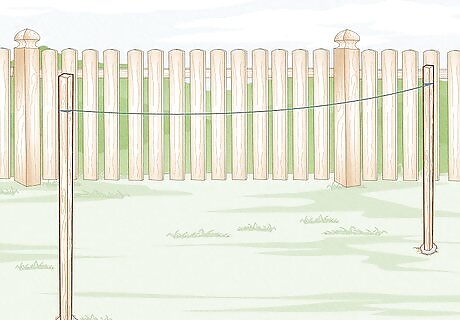
Install a clothesline. This can be as simple as one you put up yourself by stretching a nylon rope between two wooden posts. There are also retractable clotheslines, freestanding-frame rotary (umbrella) clotheslines, and pulley clotheslines for loading clothes from a fixed location. A variety of materials, such as paracord, plastic rope and cotton or Hemp Cording will work well for a clothesline. Be careful about which trees you use for the ends of your clotheslines. Conifers drip sap, and some are common roosting places for pigeons.
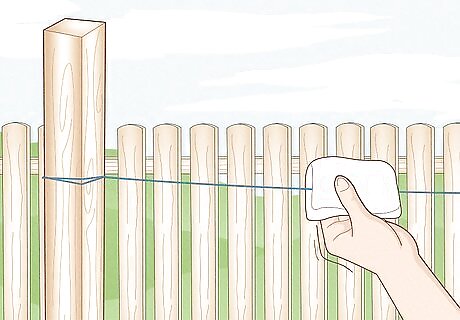
Keep your clothesline clean. If your clothesline is not wiped down regularly, it will accumulate dirt, sap, and other soiling over time. Naturally, this can transfer onto your "clean" clothes, so to prevent this from happening, give the clothesline a quick wipe-down with a kitchen sponge and a bit of detergent and water every month and allow it to dry before using. Also clean the clothespins regularly, as they can sometimes get dirty, or even build up soap residue. Throw out broken ones, and remember that you can never have too many clothespins, so replace them regularly as well.
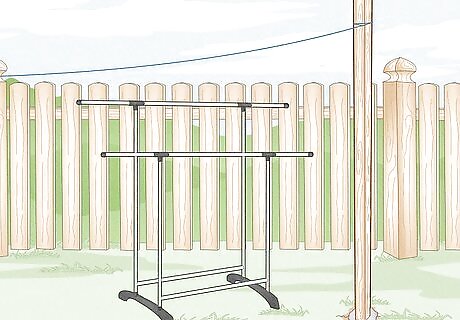
Add a clothes rack. These days, there are excellent foldaway rack options available made from lovely new materials that won't snag your clothes. Alternately, you could put a table near the clothesline for items that must be laid flat to dry rather than hung up. An old folding table can be easily turned into a sweater-drying stand. Simply remove the table top and replace with nylon netting (or a similar waterproof surface). The beauty of this is that it can be easily folded away when not in use!
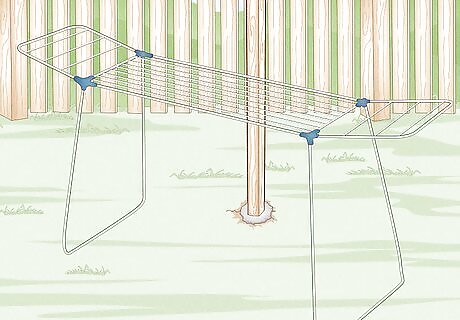
Get a clothes horse. This can be used for a variety of delicate clothing items or for small loads that you'd like to place just outside the door, on a porch (with a waterproof floor), or to catch an unusual patch of sunshine in your yard that might not be big enough for the clothesline. If there is a child around, choose a clothes horse with safely-spaced rods instead of potentially dangerous strings. The clothes horse has the benefit of being portable, so you can even "chase the sun" if you like as the shadows move around your yard.
Choosing Clothespins
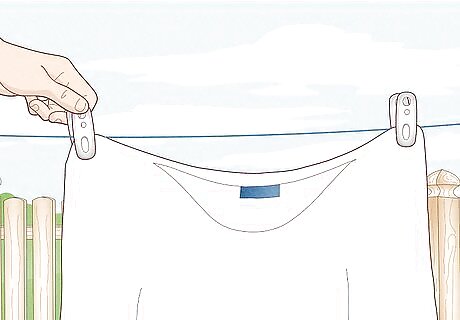
Use metal clothespins for items that won’t stretch. Stainless steel clothespins are ideal for sheets, towels, play clothes, and any other items that won't pull out of shape or stretch. Metals pins can easily secure bedding and other heavy items and they won’t rust or decay. Stainless steel clothespins last the longest.

Use wooden clothespins for sturdy items. Sheets, blankets, pillowcases, and sturdy clothing such as denim can be hung with wooden clothespins. Delicate clothing or items with lace, beading or other trim should not be held by wooden clothespins, as they can catch and tear the fabric. Wooden clothespins can also develop mildew, so be sure to allow them to dry before storing them.

Use plastic clothespins for cotton and stretchy materials. Plastic clip-on pins are best for underwear, t-shirts, knit items, and stretch wear. They won’t stain or catch on your clothing, and lighter items will be held securely by plastic clothespins.

Store your clothespins indoors. The outdoor elements can deteriorate your clothespins quickly. Allow them to dry after use, collect them in a plastic container, then store them indoors, such as in the laundry room.
Hanging Items to Dry
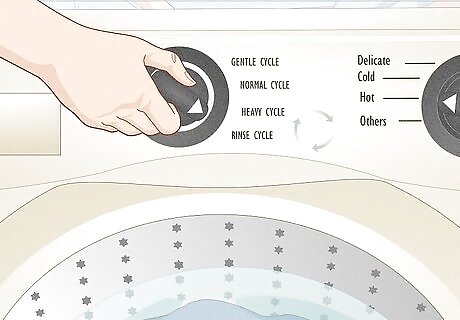
Run an extra spin cycle if your washing machine has one. This will help drive excess water off and save time. Otherwise, simply wash your laundry as usual. Then, remove the clothing from the washing machine and take it to the clothesline in a laundry basket. If a shorter drying time is not needed, save the cost of electricity for the extra spin if the laundry can be left on the line longer.

Use a plastic clothes hanger to dry delicate fabrics. Place the piece of clothing on a plastic hanger and clip the hanger to the clothes line to prevent the hanger from blowing off the clothesline. Be careful using hangers on the line on a windy day, as the hanger might blow off, or the item slip off the hanger. You may need to pin the clothing with great care to the hanger, and only ever use plastic hangers to avoid staining.
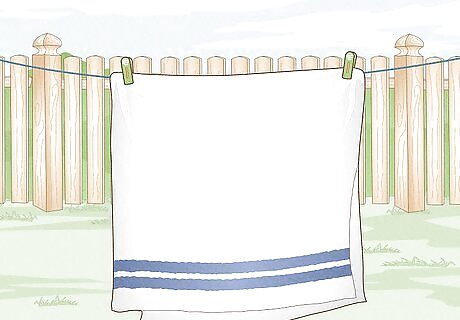
Hang towels. Hang towels by folding them over the line one end and pinning each end. To help achieve a softer dry, shake towels a lot before hanging them on the line, with a "snap." Doing this loosens the pile. Do it again when removing them from the line. Towels that dry faster on the line can feel softer, such as hanging them out on a windy, warm day. You could give them a quick 5 minute tumble in the dryer before hanging them up or after bringing them in off the line. Adding vinegar to the rinse cycle might also help to reduce towel stiffness.
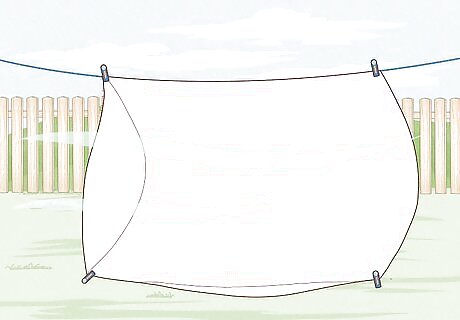
Hang sheets. Hang sheets by folding hem to hem, pinning one hem over the line, then pinning the other hem to the corners of the first hem, just a few in/cm inside the first hem corners. Have the sheet open toward the wind, to allow it to billow like a sail, and run your hands down the edges to ensure it is hanging square and even. Widthwise is best for hanging items such as sheets, tablecloths, and flatwork because it takes up less space on the line and puts the stress on the warp yarns (the yarns that run lengthwise), which are stronger than the filling yarns. Hang blankets and other heavy items across two lines, or more, as needed. Always hang pillow cases and similar items with the open side down.
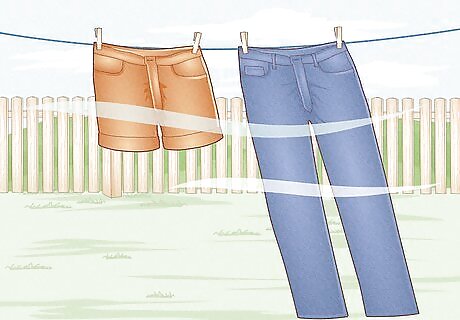
Hang pants and shorts. Pants and shorts can be line-dried. Hang shorts and pants/trousers by the waistband on the line if you want to minimize wrinkles.
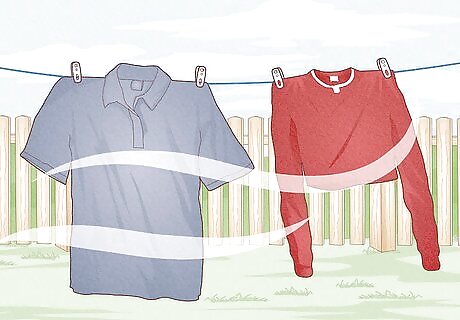
Hang tops. Most tops can be hung on a clothesline. Hang t-shirts by folding the hem a little over the line and pinning on at each end. When hanging 100% cotton items, don't pull or stretch the wet clothing and pin it, as this may cause items to widen.
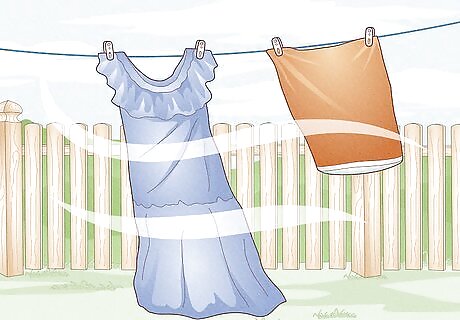
Hang dresses and skirts. Most dresses and skirts can be line-dried, although you may want to use a hanger to reduce wrinkles. Hang dresses from the shoulders if straight, or from the hem if it has a full or gathered skirt. Hang straight skirts by turning over the waistband and pin each side; hang gathered or full skirts by the hem.
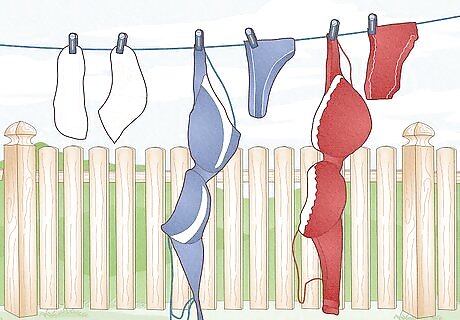
Hang undergarments. Hang socks by the toes, bras by the hook end, and fold the waistband of underpants over the line and pin either side onto the line. Fold handkerchiefs in half over the line and pin at each end.
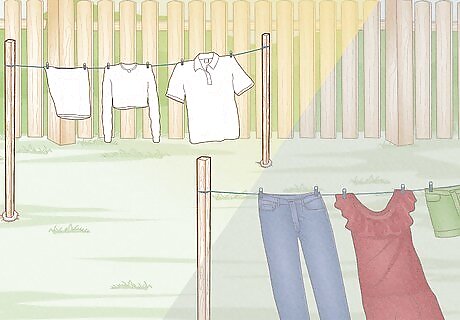
Hang colored clothes in the shade and whites in the sun. To keep your colored items from fading, you should hang them in the shade. White clothing and linens can be hung in the sun, which will naturally bleach the items. Alternatively, you can hang colored items inside out to preserve the fabric dye.

Attach clothespins in discreet locations. To prevent clothes pin imprints on clothing, try to pin the clothes in discreet locations. If you hang clothes with care, line drying can often result in clothing that dries without wrinkles, saving on ironing time. To conserve clothespins, overlap garments and use one pin to hang the end of one piece of clothing and the beginning of the next. This can be space-saving on the line as well, although don't do it where the overlapping would prevent drying on thick items. Use caution when overlapping colored items to be sure the dye doesn’t bleed.
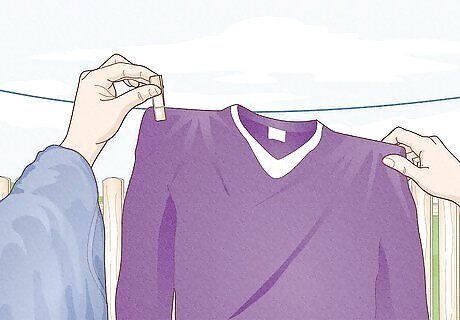
Rotate the clothes. Different clothes and fabrics dry at different rates. If you need to free up line space, check regularly for dried items, remove them, and add new wet items to the line for drying. Sheets are a great thing to get off the line quickly, as they'll dry fast but also take up a lot of space.
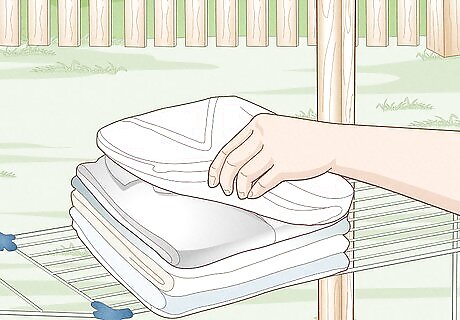
Fold the clothes as you take them off the clothesline. This saves time on ironing and also makes putting them away easier. As you remove the clothes from the line, shake and snap them to restore shape, then fold neatly. If you intend ironing the clothes, remove them slightly damp and iron them immediately. Do not store damp clothes. They will grow mildew. If you toss clothes into the basket without caring how they fall in, you will have a basket filled with wrinkled clothing. Not only is this disheartening but it undoes all the good you did hanging the clothes so carefully!
Laying Items Flat to Dry
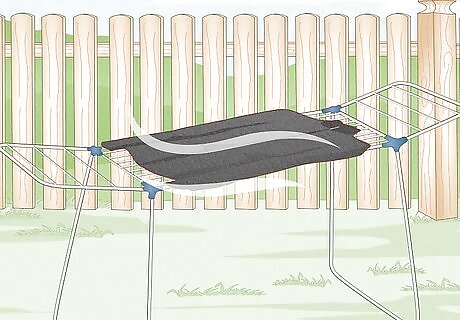
Lay wool and loosely knitted garments flat. Items that stretch when wet such as wool and loosely knitted garments should be dried flat on a surface such as sweater drying rack. This can still be placed outside, perhaps on a table or other clean surface.
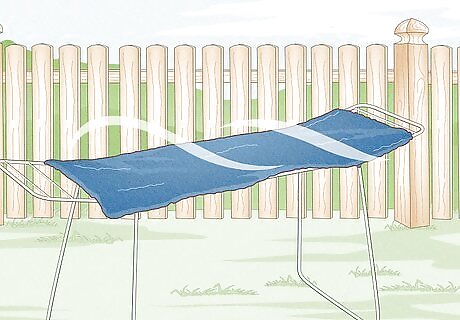
Lay textured materials flat. Some items might not look as good after line drying, such as flannelette, terry cloth, chenille, and napped or pile fabrics. It pays to test each item rather than assume the item won't look good, as most fabrics will line dry fine. If the care label says not to dry in direct sunlight, hang the item over the clothes horse in the shade or indoors instead.
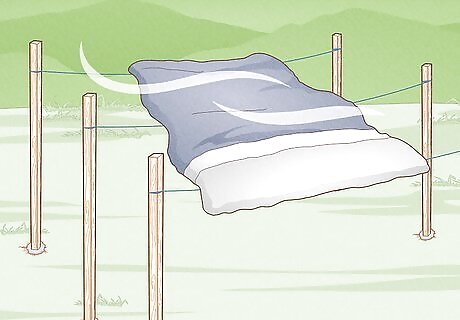
Lay items flat that contain down. Sleeping bags and duvets don't always dry so well on the clothesline because the down can drop to one end. To avoid this, hang them across several lines, as if they were like a tablecloth covering a table. This will evenly distribute the weight. For example, you can wash a down jacket in a large tub with a small amount of natural detergent. Then lay it flat to dry. Fluff it up to avoid down from sticking together.
Choosing Good Drying Weather
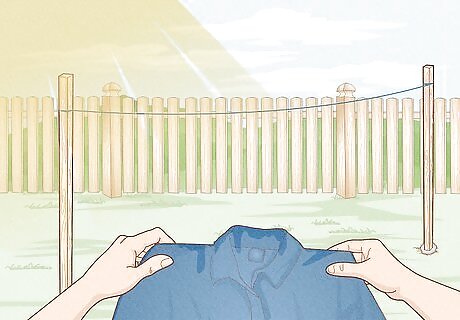
Pick warm and sunny days. The best weather for drying clothes outdoors is a warm, sunny day. A slight breeze will help your clothing dry faster. It is more important to have a good breeze than it is to have direct sunlight. The sun can fade your clothes, so don't leave them out too long! To lessen fading, dry clothing inside out or dry them in the shade, and collect the item as soon as it has dried. Airborne pollen may cling to clothes, so watch out for your outside clothes-drying aggravating your allergies. If it does, use a dryer in the spring.
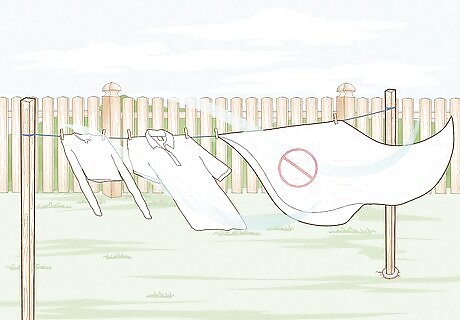
Avoid very windy days. A slight breeze is ideal for drying clothes, as the breeze will "iron out" the wrinkles for you and speed up drying time. However, strong and gusty winds can result in your clothes being blown away or into a neighbor’s yard. There is also an increased risk of clothes catching on wire, plants, etc. and ripping. Clothespins will hold best on a windy day if placed at an angle.
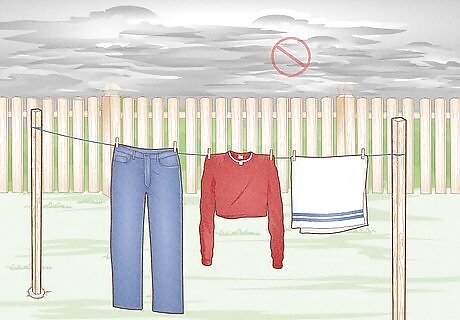
Don’t dry your clothes outside if a storm is coming. If you know the winds are going to kick up, or it’s likely to rain, don’t put your clothes outside to dry. Wait for another day, hang the items inside, or use the dryer. You can also use a rotary clothes dryer cover such as the Rotaire Dryline. It fits over a rotary line and allows you to dry clothes outside even when it's raining! You could also cover your rotary dryer with a piece of polyethylene (or an old shower curtain) to keep your clothes dry.
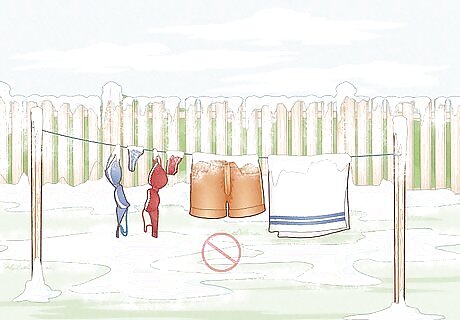
Don’t dry your clothes outside in freezing temperatures. Not only will you be cold, but your clothes will take too long to dry. If it's really cold your clothes will freeze, and since water expands when it freezes, so will the fibers in your clothes and they may not revert to their original shape. You can dry clothes in the basement, on a line or on racks, during the winter if the clothes are wrung out well beforehand. However, avoid doing this if you live in an already humid environment, as you'll be increasing the humidity.


















Comments
0 comment